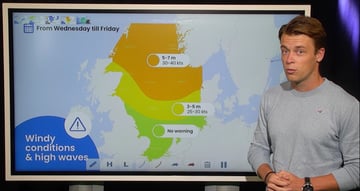Observations are a crucial component of marine meteorology as they provide real-time, on-site information that can enhance the accuracy of weather forecasts. Many observations nowadays are made with the help of advanced equipment, but in some situations conducting visual observations might be the only option. In this article we will discuss some examples of visual observations, their importance, the criteria they should meet, and practices to avoid.
Visual observations are usually not as accurate those made by advanced equipment like anemometers and wave height sensors. Even more so, many weather or wave parameters cannot be done without proper equipment. However, technology is not everything and visual observations may still be of great help in certain situations.
Examples of Visual Observations
Being outside and exposed to the elements might tell you more about the current weather conditions than looking at data coming in on your computer screen. It also gives you an idea of what the numbers on your screen actually feel like. By looking up at the sky, you can immediately identify and report cloud cover (e.g., 4 oktas of cumulus clouds) and types (e.g., cumulonimbus or stratus clouds). Looking straight ahead allows you to estimate visibility distances (e.g., "visibility reduced to 2 nautical miles due to fog"). Looking out at sea gives you the possibility to describe the sea conditions (e.g., "sea state moderate with waves 1.5 to 2 meters high"). On top of that, it can be very helpful to report any other significant weather event, like a waterspout or incoming thunderstorms.
Importance of Visual Observations
Besides being important to fine-tune the forecasts, visual observations provide immediate information on current weather conditions, which can be crucial for real-time decision-making during your marine operation. Furthermore, these observations serve as a ground truth, verifying and complementing data from automated instruments and satellite imagery. Visual observations may capture details that instruments might miss, such as the type and structure of clouds, sea state, visibility conditions, and other unusual weather phenomena. They also offer insights into specific, localized weather conditions that might not be detected by a fixed weather buoy.
Criteria for Effective Visual Observations and Practices to Avoid
When conducting visual observations, it is important to keep your observations as accurate and consistent as possible. It is crucial to avoid certain practices that can compromise the accuracy and reliability of your data. Observations must always remain objective - do not let personal interpretations or assumptions influence the outcome. Always stick to what you can objectively see and measure. Additionally, maintaining consistency in your reporting is crucial. Irregular or sporadic observations are difficult to work with and makes it impossible to detect trends in our forecast quality. Sticking to a regular observation schedule ensures more reliable results. Proper training is also essential. Without it, critical elements such as cloud types or weather phenomena can be easily misidentified, leading to incorrect forecasts. The most important thing to keep in mind while conducting visual observations is safety. Always prioritize safety over data collection, especially in bad weather conditions.
Conclusion
Being able to consistently and accurately make visual observations is especially helpful when advanced equipment is not available or when the output of this equipment is incorrect. By following the above guidelines, visual observations can significantly improve marine weather forecasting, providing crucial, real-time information that enhances the safety and efficiency of marine operations. Visual observations can also serve as an excellent supplement to electronically obtained weather data.




